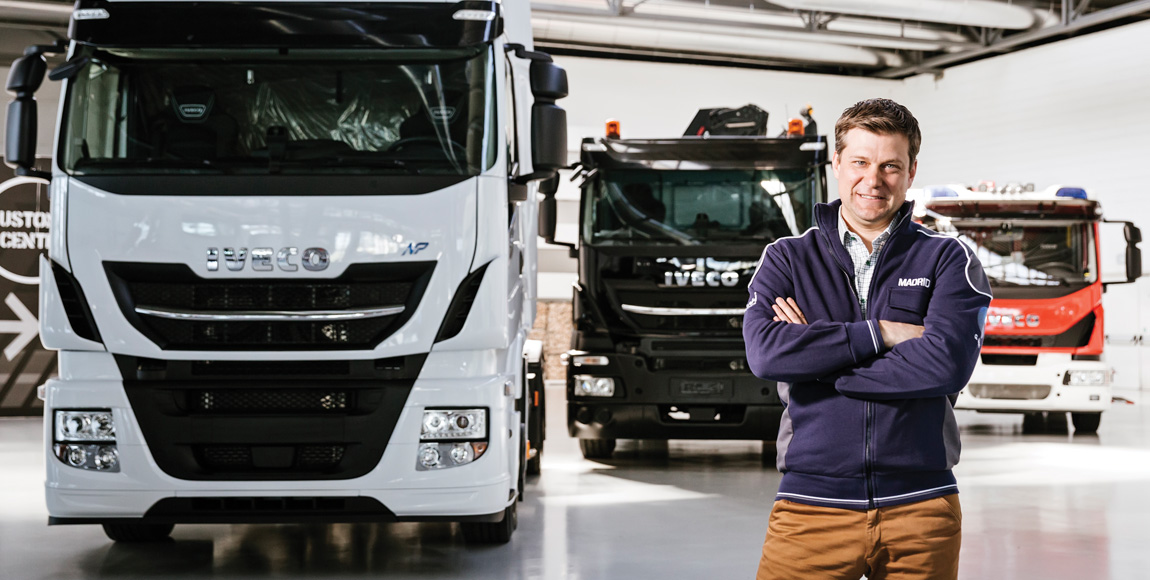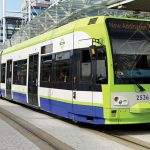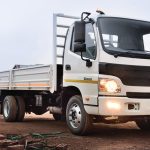Iveco’s future revealed

What does the future hold for Iveco? That was one of the things GIANENRICO GRIFFINI aimed to establish when he went face to face with Gerrit Marx, president of commercial and specialty vehicles at CNH Industrial
In January, CNH Industrial launched a new organisational structure. Can you explain how it works?
The new organisation simplifies the structure by strengthening our five global segments: agriculture, construction, commercial and specialty vehicles, powertrain and financial services. Each segment is fully responsible for the global growth and performance of its business, which gives us more focus and accountability.
The new set-up brings the businesses closer to the customer and facilitates a faster decision-making process. In our specific case, having regrouped trucks, buses, coaches, off-road and quarry vehicles together with firefighting, protection and civil defence vehicles, all under one roof, will boost the drive on internal synergies and brand empowerment.
In addition, the five operating segments are supported by streamlined global functions focused on core company tasks such as strategies, emerging technologies, systems and processes, and supply chain. They have the task to support the segments enabling faster decision-making and guaranteeing the adequate synergies inside the organisation.
With this set-up, we aim to become more customer-centric, by enhancing focus on our five operating segments; more entrepreneurial, by reducing complexity and empowering these segments; leaner and more agile, through simpler, more streamlined decision-making processes; and more innovative, by enabling faster and more market-focused innovations.
What changes does this new organisation involve? What benefits do you offer to Iveco customers?
First of all, the new organisation brings together the group’s Iveco commercial vehicle business with the bus and coach, firefighting and defence vehicle brands to create the new commercial and specialty vehicle segment.
It will build on the strong heritage of the brands that are coming together, which have deep European roots and have made important contributions to the history of their respective sectors – illustrious brands such as Magirus, an internationally recognised authority on firefighting and emergency vehicles.
By giving us full accountability for the global growth and performance of our business, the new set-up gives us the freedom to anticipate, change and adapt to the fast-changing environment in which we operate.
The leaner organisation also gives us the flexibility to innovate and the speed we need to be more effective, more focused on being close to our customers and providing the solutions they need, while addressing the key industry trends that matter and make a difference to their businesses.
The key to success is to present the customer with an offer that goes beyond a commodity: a vehicle complemented by a whole range of services. Our customer-centric mindset will drive our organisation to continuously improve the aftermarket support we offer our customers, which aims to provide them with a complete solution that addresses their operational and business needs.
The press release announcing the new structure says the company will accelerate its activities in the areas of automation, vehicle electrification, digitisation and servitisation. Some of these words sound pretty new in Iveco’s language. What does it mean for Iveco and Iveco’s product portfolio? Is it a strategic change?
Automation, vehicle electrification, digitisation and servitisation are not new to Iveco: just think about our Daily Electric or our market-leading buses; the TCO2 Live services that we introduced with the Stralis in 2016, which were already a first example of servitisation; our participation in the European Union (EU) Platooning Challenge.
The new organisation enables us to accelerate our progress in these megatrends, and to anticipate and meet our customers’ demands. It is focused on offering them a whole range of services enabled by digitalisation.
We are about to launch a new vehicle with new services that leverage digital technology to maximise the uptime, productivity and fuel efficiency of our customers’ vehicles. And we will continue to develop and expand these new services, which will become an increasingly important part of the complete package that our vehicles will offer our customers.
The new organisation will also allow us to continue to innovate in vehicle electrification, as we have been for some time, and accelerate this process. I will just mention one of many award-winning innovations we have made in this field: the Iveco Bus CREALIS In-Motion-Charging, which won the Move Green innovation award at the Paris Public Transport Show and the Sustainable Bus of the Year title at the IAA.
This bus is seen as the e-bus solution with the highest operational potential, because it never needs to stop for charging. It has a small set of batteries, which enable it to operate free of the overhead lines and recharge in motion when the bus is reconnected to the lines.
Electric traction technology in its current state of development is viable for urban mobility; it has an important role to play especially at low speed, low energy intensity stop-and-go missions – and particularly in high-value missions such as people transport in city centres.
However, it is important to remember that electricity is clean only if it comes from a clean generation process. A vehicle running on electricity generated from coal is only moving polluting emissions from the city to the site of the power plant.
Another important consideration is about the battery and its material extraction, its cost, its weight, its end of life, recycling and ultimate overall environmental balance.
Long-haul applications will follow in the longer term, and in the coming years we will see an evolution that will transform the industry.
What role will gas vehicles and liquefied natural gas (LNG) technology have in Iveco’s future in the long-haul segment?
We have a clear investment roadmap for Iveco to consolidate and grow our position in each segment, namely light, medium and heavy commercial vehicles. We are leading the way in natural gas technology, and we will continue to invest in order to maintain this leadership in the LNG vehicle market.
In the medium term, we see LNG as the only sustainable fuel for long-haul transport that presents a viable alternative to diesel from the point of view of total cost of ownership. We see it as the best technology in this segment both for the CO2 reduction it achieves and for the new European policies supporting the use of gas, such as the motorway toll exemption in Germany, or the decrees to promote the use of biomethane from cow manure and agricultural waste in France and Italy.
The necessary infrastructure is also developing, creating increasingly favourable conditions for the use of natural gas: overall, the gas distribution network today covers the main European freight routes with over 300 truck gas refuelling stations, and by the end of 2019 it is expected to extend to more than 500.
It is also worth considering the opportunities of biomethane, which can reduce well-to-wheel CO2 emissions by as much as 95 percent. The transition from low emissions to zero emissions opens the door to a circular economy approach based on the generation of energy from organic or agricultural waste.
The EU has set highly ambitious CO2 reduction targets for trucks. This could mean a rapid uptake of, say, electric/hybrid vehicles. How does this decision affect Iveco’s product development and product offering?
The targets set by the EU are indeed highly demanding, and it is very likely that electrification will come. However, this doesn’t depend only on vehicle manufacturers, but requires the infrastructure to be in place.
The charging infrastructure for electric vehicles is easier to develop in urban areas – a process that has started – while coverage of regional and longer distance routes will follow further into the future.
At Iveco we will continue to work on developing electrified vehicles for urban missions, where our customers will be able to find the infrastructure they need.
As for natural gas, the EU Parliament and Council recognise the key role of renewable gas in the transport sector, and have called upon the European Commission to develop a methodology which we urge must be applicable by 2025 to include the CO2 emissions reduction effect from bio-compressed natural gas (CNG) and bio-LNG in the computation of average fleet emissions.
At Iveco, we see natural gas as the mature solution available today to achieve sustainable heavy-duty transport, and we will continue to invest in this technology to enable our customers to operate their fleets profitably while meeting these ambitious targets.
What new products will you launch in the coming months?
This year we have important launches covering all our ranges. They are the end result of significant investments and big projects involving our engineering and manufacturing teams.
You will see that they introduce some key innovations, and we expect them to be very competitive on the market, setting the foundation for our future growth.
We have already launched the New Daily. This product family has a long history of 40 years of success, and the latest arrival is more competitive than ever. Very soon we will follow up with great news pertaining to our heavy range too.
Iveco is here to stay, compete and win across the segments where we compete today – from light to heavy trucks, buses and specialty vehicles.

Do you think the New Stralis – or whatever its name is – will be able to boost Iveco’s sales in EU markets, and, say, boost Iveco’s market share to a double-digit figure in the heavy-duty segment?
Yes, absolutely. The market is coming out of a difficult time, and we are bringing in an extremely competitive product. We have invested heavily in the Stralis, and the new range will raise the bar in fuel economy, comfort and reliability.
The new organisation will also play a role, and will help us to be more aggressive on the market. We are confident that these factors together will enable us to increase our volumes and improve our market share.
Do you think Iveco has the right size and footprint around world to stay independent? Are you looking for an international partnership, merger or technical agreement perhaps?
Iveco is the fifth-largest manufacturer of commercial vehicles in Europe. We are a leader in the LCV segment, thanks to our best-seller, the Daily – not only in Europe but also in China – and we are at the top of the medium range.
Furthermore, we are the leader in natural gas-fuelled vehicles, with CNG and especially LNG for long-haulage transport, where we enjoy a clear predominance in market share. We are already thinking about the future as well, and are considering hydrogen fuel cells for instance: our sister Brand FPT unveiled a first prototype during the last IAA, in Hanover, mounted on our Iveco chassis.
If we turn to buses, our Intercity range is dominating the market, and now we have an electric range for urban buses, with Heuliez Bus.
In the specialty business, last year we won a momentous tender with the United States Marine Corps, to provide the next generation of their amphibious combat vehicles with Iveco Defence Vehicles.
Looking abroad, I have already touched on China with the Daily, but we also see a market recovery in South America, driven mainly by favourable borrowing rates, old fleet renewals and increased freight for agriculture.
As the commercial and specialty vehicles division, we run more than 20 manufacturing plants around the world, including joint ventures, and nearly the same number of research and development centres.
We definitely have the right size, the right footprint and – I would add – the technological advantage to remain competitive in the market on our own and face the industry’s upcoming challenges.
Published by
Focus on Transport
focusmagsa




